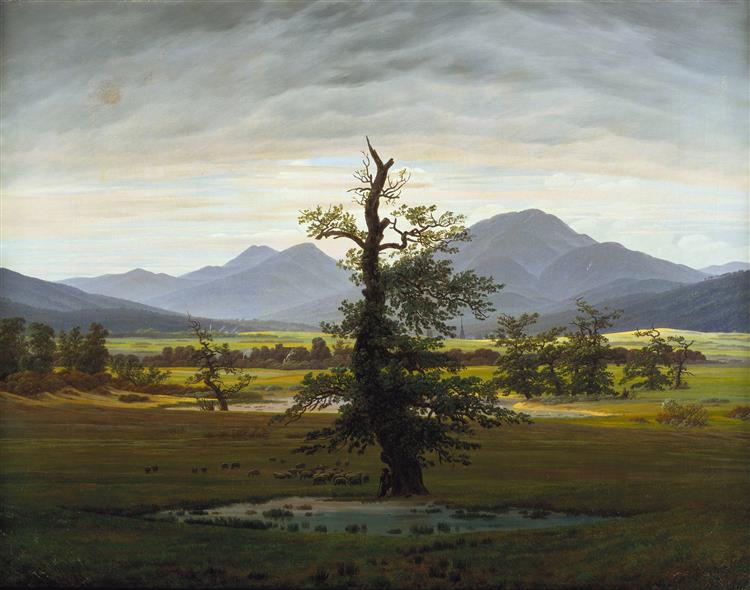Description
Caspar David Friedrich's painting "Lonely Tree" (1822) is an iconic work that encapsulates the essence of Romanticism, a movement that sought to explore human emotions in relation to nature. Friedrich, renowned for his ability to evoke deep feelings through landscapes, offers in this work a silent contemplation that invites the viewer to reflect on solitude, permanence, and the fragility of existence.
At the centre of the composition stands a robust tree which, although solitary, appears with a serene majesty. The tree, with its outstretched branches, stands in front of a horizon where the sky is embellished by a colour palette that transitions between the warm tones of a sunset and the cold hues of a twilight sky. This duality of colour highlights both the warmth of life and the imminent arrival of night, suggesting a cycle of life and death, as well as the individual's struggle against the passing of time.
The work is devoid of human figures, making the solitary tree the sole protagonist. Its loneliness can be interpreted as a symbol of the human condition: the human being, like the tree, faces instances of isolation and the search for meaning in a vast and indifferent world. This theme of loneliness is recurrent in the work of Friedrich, an artist who often portrayed landscapes with natural elements that evoked both beauty and melancholy.
The use of space in “Lonely Tree” is remarkable. The tree occupies an almost central position, but shifted to the left, allowing the viewer’s gaze to be drawn towards the background of the landscape, where the sky and vegetation merge in a delicate balance of light and shadow. The contrast between the robust texture of the tree’s bark and the softness of the sky adds a tactile dimension to the work, inviting viewers to imagine the feeling of being in that very place, experiencing both serenity and melancholy.
Friedrich's influence on later movements is particularly felt in the way this work evokes introspection. His ability to capture the connection between man and nature has resonated in diverse artistic contexts throughout the centuries. Although his style is distinguished by a unique focus on the sublime, a parallel can be seen in how other artists have depicted solitude and nature, including the work of his contemporaries and successors.
The Lonely Tree must also be considered in the context of its time. In the 19th century, the perception of nature was beginning to change, and the Romantics, including Friedrich, used painting as a form of social commentary, a reflection on the increasingly distant relationship between humans and their natural environment. Friedrich, in particular, becomes an icon of this exploration, using nature as a mirror of human emotions.
The work, though seemingly simple in composition, reveals complexities in its symbolism and technique. Meticulous attention to detail, the ability to create an enveloping atmosphere, and a deep emotional connection combine to make “Lonely Tree” a centerpiece in Friedrich’s oeuvre and in the history of Romantic art. The painting is not only a depiction of isolation, but also a reminder of the beauty that can be found in solitude. Ultimately, “Lonely Tree” remains a poetic uprising against the elements, an enduring testament to the struggle between life and the inexorable passage of time.
KUADROS ©, a famous painting on your wall.
Hand-made oil painting reproductions, with the quality of professional artists and the distinctive seal of KUADROS ©.
Painting reproduction service with satisfaction guarantee. If you are not completely satisfied with the replica of your painting, we will refund 100% of your money.

